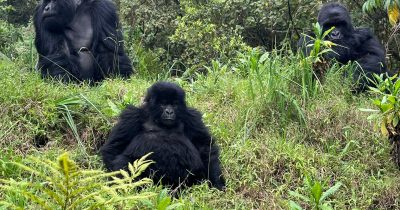Shetani Lava and Roaring Rocks in Tsavo West National Park
Everything you must know about Shetani lava and roaring rocks in Tsavo West National Park. Located in the heart of Kenya, Tsavo West National Park is a captivating expanse that showcases the country’s rich biodiversity and unique geological features. Among its most intriguing attractions are the Shetani Lava Flow and the Roaring Rocks. These natural wonders not only offer breathtaking views but also narrate the geological history of the region, drawing visitors from all over the world.
The Shetani Lava Flow
Geological Significance
The Shetani Lava Flow, which translates to “the place of the devil” in Swahili, is a striking geological formation resulting from volcanic activity. Formed approximately 200 years ago, the flow is a remnant of a major eruption from the nearby Chyulu Hills. The ancient lava has solidified into a rugged terrain, creating a stark contrast against the surrounding savanna landscape.

The dark, jagged rocks of the Shetani Lava Flow stretch over 13 kilometers and vary in height, providing a unique habitat for various plant and animal species. The area is a testament to the power of nature, illustrating the dynamic processes that shape our planet.
Flora and Fauna
Despite its seemingly inhospitable environment, the Shetani Lava Flow supports a surprisingly diverse ecosystem. Hardy plants, such as acacia and various grasses, have adapted to thrive in the nutrient-poor volcanic soil. These plants play a crucial role in stabilizing the soil and providing shelter for wildlife.
Visitors to the Shetani Lava Flow may encounter a variety of animals, including elephants, giraffes, and different species of antelope. The area is also home to numerous bird species, making it a prime spot for birdwatching enthusiasts. The contrast between the barren lava landscape and the vibrant life it supports is a captivating sight.
Cultural Significance
The Shetani Lava Flow holds cultural significance for local communities. Traditionally, the area was perceived with a sense of reverence and mystery, often linked to local folklore. The name “Shetani,” which translates to “devil,” stems from the belief that the area was once inhabited by supernatural beings. Today, it continues to intrigue visitors, merging natural beauty with cultural narratives.
Roaring Rocks
Geological Features
Roaring Rocks, located near the Shetani Lava Flow, are characterized by their dramatic cliffs and unique echoing sounds. The rocks are a result of geological processes that have shaped the Tsavo landscape over millennia. As water and wind erode the softer rock layers, the harder layers remain, forming rugged cliffs that rise dramatically from the surrounding plains.
The name “Roaring Rocks” comes from the sound produced when the wind rushes through the crevices and caverns of the rocks, creating a haunting, echoing roar. This phenomenon captivates visitors, adding an element of mystery and allure to the site.
Views and Wildlife
The vantage points provided by Roaring Rocks offer some of the most breathtaking views in Tsavo West. From the summit, visitors can gaze across the expansive savanna, spotting herds of wildlife far below. The panoramic landscape showcases the park’s diverse ecosystems, from lush valleys to arid plains, all framed by the distant Chyulu Hills.
Wildlife is abundant in this area, with the possibility of encountering elephants, lions, and various antelope species. The diverse habitats surrounding Roaring Rocks support a rich variety of flora and fauna, making it a prime destination for wildlife enthusiasts and photographers.
Adventure and Exploration
For the adventurous spirit, Roaring Rocks offers opportunities for hiking and exploration. The rugged terrain invites visitors to trek along the trails, discovering hidden viewpoints and unique geological formations. The thrill of standing atop the cliffs, feeling the wind rush past, and listening to the echoes of the rocks is an experience that leaves a lasting impression.
Conservation Efforts
Both the Shetani Lava Flow and Roaring Rocks are part of the larger conservation efforts within Tsavo West National Park. Established in 1948, the park aims to protect the unique ecosystems and biodiversity that thrive in the region. Conservation initiatives focus on habitat preservation, anti-poaching measures, and community engagement to ensure that these natural wonders remain for future generations.
Local communities play a crucial role in conservation efforts. Through education and sustainable tourism practices, they are encouraged to participate in the protection of their natural heritage. The Shetani Lava Flow and Roaring Rocks serve as important symbols of this collaboration, illustrating the balance between human activity and nature.
Best Time to Visit Tsavo West National Park
The best time to visit Tsavo West National Park is during the dry season, which typically runs from June to October. During this period, wildlife is more easily spotted as animals congregate around water sources. The clear skies and pleasant temperatures make it an ideal time for hiking and exploring the Shetani Lava Flow and Roaring Rocks.
Access and Accommodation
Tsavo West is accessible by road from major cities like Nairobi and Mombasa. Various accommodations are available within and around the park, ranging from luxury lodges to budget-friendly campsites. Visitors can choose based on their preferences and budget, ensuring a comfortable stay while exploring the park’s natural wonders.
Guided Tours
For an enriching experience, guided tours are highly recommended. Local guides possess a wealth of knowledge about the park’s history, geology, and wildlife. They can provide insights that enhance the visit, making it more memorable and educational.
Ready to go?
The Shetani Lava Flow and Roaring Rocks are two of the many natural wonders that make Tsavo West National Park a unique destination. These geological formations not only showcase the power of nature. It also offers a glimpse into the rich biodiversity and cultural heritage of the region. As conservation efforts continue, these landmarks will remain vital parts of Kenya’s natural landscape, inviting future generations to explore and appreciate their beauty. Whether you are an avid adventurer, a wildlife enthusiast, or a lover of natural history, a visit to these remarkable sites is sure to leave an indelible mark on your journey through Kenya.















